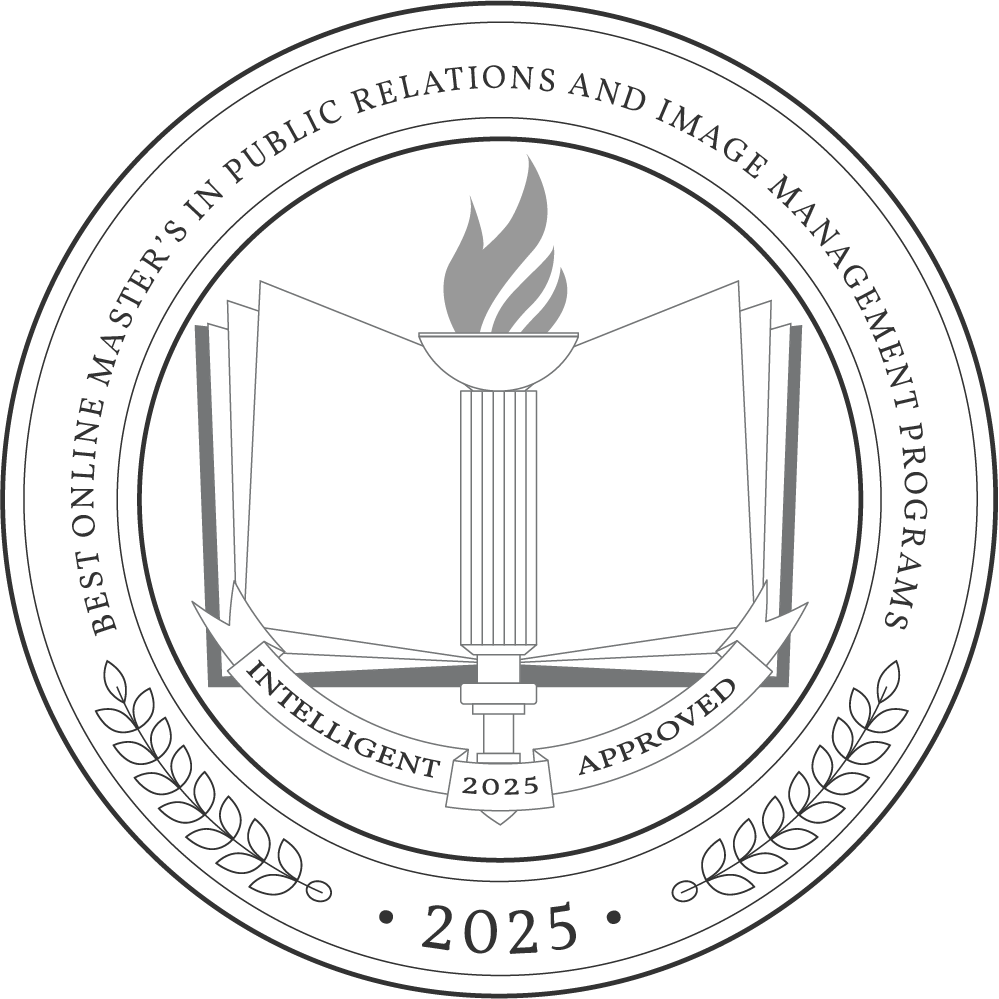An online master’s in public relations and image management prepares students for dynamic roles in media, corporate communications, and public affairs. Graduates are equipped to become public relations managers, media directors, and communications specialists. According to the Bureau of Labor Statistics, public relations managers earn a median salary of approximately $130,480 annually.
The program typically takes one to two years to complete, depending on whether students are enrolled full-time or part-time. Costs vary, with average annual tuition costs ranging from roughly $12,500 to $30,000. Online programs offer flexibility, allowing students to balance their studies with professional commitments while gaining the skills necessary to manage public perception and enhance organizational image effectively.
Why Trust Us
The Intelligent.com Higher Education Team is dedicated to providing students with independent, equitable school and program rankings and well-researched resources. Our expert-driven articles cover topics related to online colleges and programs, paying for school, and career outlooks. We use data from the U.S. Department of Education’s College Scorecard, the National Center for Education Statistics, and other reputable educational and professional organizations. Our academic advisory team reviews content and verifies accuracy throughout the year for the most current information. Partnerships do not influence rankings or editorial decisions.
- Analyzed over 2,000 national, accredited, and nonprofit colleges and universities
- 800+ rankings pages are reviewed and updated yearly
- Content is informed by reputable sources, surveys, and interviews with academic advisors and other experts
- Over 100 data points are reviewed for accuracy and quality throughout the year, including sources
How we rank schools
Our list features the best online Public Relations and Image Management degree programs at top colleges nationwide. Each school featured is a nonprofit, accredited institution — either public or private — with a high standard of academic quality for post-secondary institutions.
We evaluated each school’s program on tuition costs, admission, retention and graduation rates, faculty, reputation, and the student resources provided for online students. We collected data from trusted sources like the National Center for Education Statistics, individual school and program websites, school admissions counselors, and other data sources. Then, we calculated the Intelligent Score on a scale of 0 to 100 based on the following criterion:
Academic Quality:
- Admission rate versus enrollment rate
- Retention rate of students who return after year one
- Accreditation status (regional and programmatic)
- Nonprofit status, both private and public institutions
Graduation Rate
- Overall graduation rate
- Total number of currently enrolled students, including diversity metrics
- Student-to-faculty ratio
Cost and ROI
- In-state and out-of-state per-credit tuition rates and fees
- Required credits to graduate
- Earning potential after graduation
- Availability of federal student loans, scholarships, and other financial aid options
Student Resources
- Available student services for online-only and hybrid programs
- On-campus amenities like tutoring centers and the number of libraries
Read more about our ranking methodology.
Best 6 Accredited Online Master's in Public Relations and Image Management Programs
FiltersInstitution Type
Status
- Intelligent Score
- Alphabetically By University Name
- Acceptance Rate
- Enrollment
- In-state Graduate Tuition
- Out-of-state Graduate Tuition
- In-state Undergraduate Tuition
- Out-of-state Undergraduate Tuition

Georgetown University
Intelligent Score: 98.80In-state: $57,384
Out-of-state: $57,384
In-state: $53,136
Out-of-state: $53,136
SAT: 1380-1550
ACT: 31-35
$1,620
Online, On-Campus
Middle States Commission on Higher Education
30.0

University of Southern California
Intelligent Score: 96.54In-state: $59,260
Out-of-state: $59,260
In-state: $47,880
Out-of-state: $47,880
SAT: 1340-1530
ACT: 30-34
$2,244
Online
Western Association of Schools and Colleges Senior College and University Commission
24.0

GW Graduate School of Political Management
Intelligent Score: 96.20In-state: $55,961
Out-of-state: $55,961
In-state: $31,770
Out-of-state: $31,770
SAT: 1270-1450
ACT: 30-33
$1,805
Online, On-Campus, Hybrid
Middle States Commission on Higher Education
30.0

Emerson College
Intelligent Score: 94.01In-state: $49,536
Out-of-state: $49,536
In-state: $31,104
Out-of-state: $31,104
SAT: 1190-1380
ACT: 27-31
$1,402
Hybrid
New England Commission of Higher Education
36.0

University of Denver
Intelligent Score: 92.81In-state: $52,596
Out-of-state: $52,596
In-state: $52,596
Out-of-state: $52,596
SAT: 1170-1360
ACT: 26-31
$806
Online
Higher Learning Commission
48.0

Indiana University - Purdue University - Indianapolis
Intelligent Score: 91.27In-state: $30,290
Out-of-state: $35,050
In-state: NA
Out-of-state: NA
SAT: 1060-1240
ACT: 21-25
In-State: $390
Out-of-State: $1,078
Online, On-Campus, Hybrid
Higher Learning Commission
30.0
How to Choose an Online Master’s in Public Relations and Image Management Degree Program
Choose your area of study
Start your search by identifying your interests within the field, such as media relations, corporate communications, or crisis management. Research different specializations offered by programs to find one that matches your career aspirations. Consider the industry demand and job prospects for each specialization. Review the curriculum and faculty expertise of each potential program to ensure that it provides comprehensive training in your chosen area. Making an informed decision helps tailor your education to your desired career path, enhancing your skills and employability in this competitive field.
Research schools and programs
Look primarily at accredited institutions to ensure a quality education at a school that is respected by employers. Accreditation may be provided by a regional organization or subject-specific accreditor, such as the Accrediting Council on Education in Journalism and Mass Communications (ACEJMC). Review program curricula to see if they cover your areas of interest, such as digital media strategies or crisis communication. Check faculty qualifications and their experience in the field. Evaluate the flexibility of the program, especially if you need to balance studies with work. Look into student support services, such as career counseling and networking opportunities.
Prepare for tests and applications
Research the specific admission requirements for the programs you are considering. This often includes standardized tests like the GRE, so allocate time for thorough preparation using study guides and practice exams. Gather necessary documents such as transcripts, letters of recommendation, and a carefully crafted personal statement that highlights your passion and experience in public relations. Tailor your resume to showcase relevant skills and accomplishments. Meeting all application requirements and deadlines demonstrates your commitment and preparedness, increasing your chances of acceptance into competitive programs.
Select your program
Ensure that the program you have chosen is accredited by a reputable organization such as ACEJMC or by a regional accreditor recognized by the Department of Education. This guarantees high educational standards. Examine the curriculum to ensure it covers key areas that are likely to be in demand by employers, such as media strategies, crisis communication, and digital marketing. Assess the faculty’s expertise and industry experience to ensure you’ll receive quality mentorship. Consider program flexibility, including part-time options and asynchronous courses, to fit your schedule. Investigate career support services and networking opportunities before making your final selection.
Determine how you’ll pay for your degree
Determine the total cost, including tuition, fees, and other expenses. Ask for assistance from an admissions counselor to be sure you’re accounting for all possible costs. Whether or not a program is accredited can affect financial aid eligibility. Complete the Free Application for Federal Student Aid (FAFSA) to access federal grants and loans. Explore scholarships, grants, and fellowships specific to public relations and communications. Additionally, check if your employer offers tuition reimbursement programs. Budgeting and planning for these expenses in advance ensures you can focus on your studies without financial distractions.
What Can You Expect From an Online Master’s in Public Relations and Image Management Degree Program?
An online master’s in public relations and image management equips students with advanced skills in managing public perception and strategic communications. Prospective students can expect to learn high-level concepts in media relations, crisis communication, digital marketing, and brand management. The curriculum often includes courses on strategic communication planning, social media strategy, and ethics in communication.
Typically, these programs take one to two years to complete, depending on whether students enroll full-time or part-time. While online programs offer flexibility, some may have specific requirements like in-person residencies, workshops, or labs. These hands-on experiences provide practical skills and networking opportunities with peers and industry professionals.
Students might also need to complete a capstone project or thesis, which involves applying theoretical knowledge to real-world public relations challenges. Regular assessments, group projects, and interactive discussions may also be integral components of the learning experience.
Potential courses you’ll take in an online master’s in public relations and image management program
- Strategic Communication Planning. Teaches students how to develop and implement comprehensive communication strategies. Topics include audience analysis, message development, and the use of various media channels to achieve organizational goals.
- Crisis Communication and Management. Students learn how to prepare for and respond to communication crises. The course covers risk assessment, crisis response strategies, and media relations during emergencies to protect and manage an organization’s reputation.
- Digital Media and Marketing. Focuses on leveraging digital platforms for public relations. Students explore social media strategies, content creation, SEO, and digital analytics to engage audiences and measure the effectiveness of online campaigns.
- Public Relations Research Methods. Introduces students to the research techniques used in public relations. Students learn how to design and conduct surveys, analyze data, and apply research findings to improve communication strategies.
- Ethics in Public Relations. Students examine the ethical issues and dilemmas commonly encountered in public relations practice. The course emphasizes the development of ethical decision-making skills and the importance of maintaining integrity and transparency in communication efforts.
Online Master’s in Public Relations and Image Management Degree Frequently Asked Questions
How do I apply to an online master's in public relations and image management degree program?
Start by completing the program’s online application form. You’ll probably need to submit official transcripts from previous educational institutions, letters of recommendation, a personal statement detailing your goals and experience, and standardized test scores like the GRE if required. Some programs may also request a current resume and a portfolio of relevant work. Speaking with an admissions counselor is crucial before applying. They can provide specific insights into the program’s requirements, help you prepare a strong application, and answer any questions about the application process.
How much does an online master's in public relations and image management degree cost?
The cost of an online master’s degree typically ranges from $12,500 to $30,000 per year in total tuition, based on data from the National Center for Education Statistics. In general, public institutions are cheaper than private schools, but financial aid packages can offset the difference. Additional expenses may include technology fees, textbooks, and course materials. Online programs can be more cost-effective than on-campus ones, as they eliminate commuting and housing costs. However, students should budget for a reliable computer and high-speed internet. Some programs may also have residency requirements, adding travel and accommodation expenses. Proper financial planning ensures you can manage these expenses effectively while pursuing your degree.
How long does it take to earn an online master's in public relations and image management degree?
Earning an online master’s degree typically takes one to two years. The duration varies based on whether you enroll full-time or part-time. Full-time students can complete the program more quickly, while part-time students may take longer due to a lighter course load. The total number of required credits, often between 30 and 45, also affects completion time. Online programs offer greater flexibility compared to on-campus programs, allowing students to balance their studies with personal and professional commitments. However, some online programs may have synchronous sessions or occasional in-person requirements, which could influence the pace of study.

